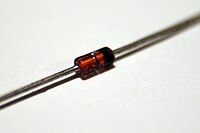
Photo from wikipedia
Abstract Origami, the ancient art of paper folding, has evolved into a design framework of a wide variety of engineering systems such as deployable structures and architected cellular materials. The… Click to show full abstract
Abstract Origami, the ancient art of paper folding, has evolved into a design framework of a wide variety of engineering systems such as deployable structures and architected cellular materials. The fundamentally three-dimensional folding is not only a capable tool to generate shape transformation, but also a powerful platform to program sophisticated elastic properties. This study investigates the multi-stability characteristics of a stacked origami cellular solid consisting of multiple Miura-ori sheets, specifically focusing on a dual-cell chain structure. Experiment results indicate that folding imposes a unique kinematic constraint between the two adjacent bistable origami cells, which can significantly increase the energy barrier of the extensional switch from one stable state to another without notably increasing the barrier of the opposite switch, creating an asymmetric barrier. We formulate a geometric mechanics model to examine the underlying physical principles of the observed asymmetric behaviors, and demonstrate the potentials to strengthen this asymmetric energy barrier and to achieve a static mechanical diode effect. That is, the multi-stable origami could be easily compressed via switching between different stable states, but demand a large external force to be extended. Since such diode effect has the potential to rectify reciprocal loads into unidirectional deformation, the results of this study can become the building blocks for origami solids with novel functionalities.
Journal Title: Extreme Mechanics Letters
Year Published: 2017
Link to full text (if available)
Share on Social Media: Sign Up to like & get
recommendations!